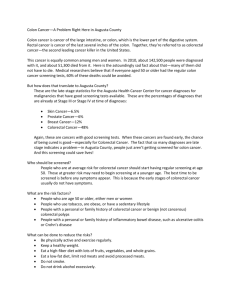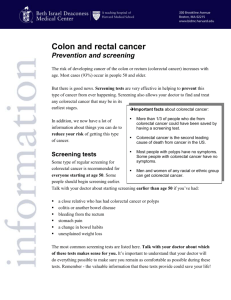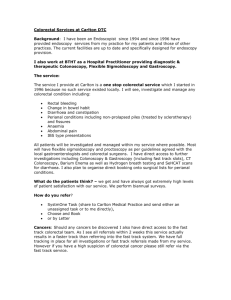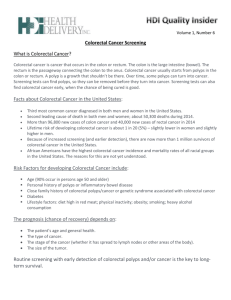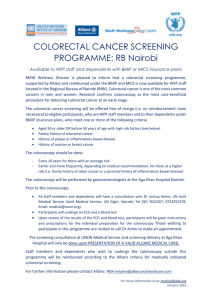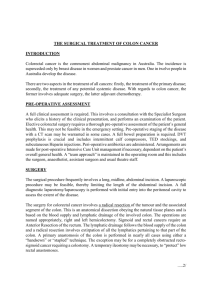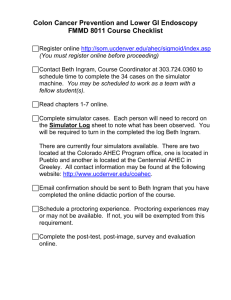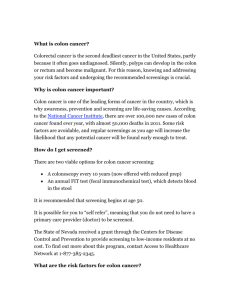Colorectal Cancer DR. F.M. BHOLAH OSK FRCP LONDON
advertisement
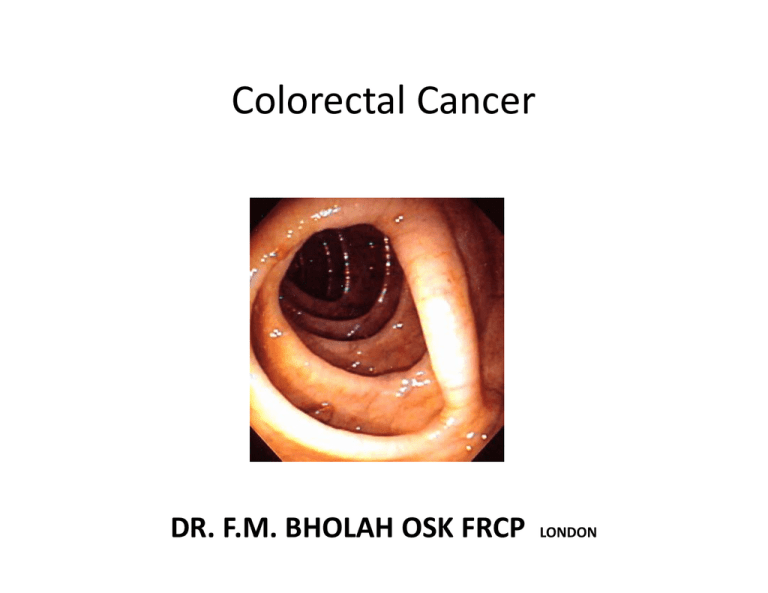
Colorectal Cancer DR. F.M. BHOLAH OSK FRCP LONDON Bowel including Anal Cancer (C18-C21): 2008 Estimates European Age-Standardised Incidence Rates per 100,000, EU-27 Countries Please include the citation provided in our Frequently Asked Questions when reproducing this chart: http://info.cancerresearchuk.org/cancerstats/faqs/#How Prepared by Cancer Research UK Original data sources: European age-standardised rates were calculated by the Statistical Information Team at Cancer Research UK, 2011 using data from GLOBOCAN, IARC, 2010, version 1.2. Available from: http://globocan.iarc.fr. Accessed May 2011. Trends in colorectal cancer incidence rates in select countries of Eastern Europe by sex (Cancer Incidence in Five Continents, 1963-2002). Bowel including Anal Cancer (C18-C21): 2008 Estimates World Age-Standardised Incidence Rates per 100,000 Population, World Regions Please include the citation provided in our Frequently Asked Questions when reproducing this chart: http://info.cancerresearchuk.org/cancerstats/faqs/#How Prepared by Cancer Research UK Original data sources: Ferlay J, Shin HR, Bray F, Forman D, Mathers C, Parkin DM GLOBOCAN 2008 v1.2, Cancer Incidence and Mortality Worldwide: IARC CancerBase No. 10 [Internet]. Lyon, France: International Agency for Research on Cancer, 2010. Available from: http://globocan.iarc.fr. Accessed May 2011. Incidence of Colorectal Ca in KSA Versus USA ASR for colorectal cancer (1994-2003) in the Kingdom of Saudi Arabia and the United States of America ASR for Incidence (KSA) ASR for Incidence (USA) Year Males Females ALL Males Females ALL 1994 3.36 3.45 3.38 40.80 28.90 33.41 1995 3.25 4.02 3.56 39.20 28.80 32.63 1996 2.93 3.73 3.25 40.70 28.20 33.01 1997 3.05 3.51 3.22 41.90 29.30 34.06 1998 3.45 3.52 3.48 41.00 30.20 34.14 1999 3.98 4.63 4.26 40.60 29.40 33.59 2000 3.70 4.28 3.95 39.70 28.50 32.82 2001 4.15 4.92 4.48 39.10 28.00 32.24 2002 5.09 5.07 5.07 38.20 28.40 32.11 2003 6.06 5.60 5.84 36.90 26.50 30.49 Source: Ibrahim, E. et al. (2008). Past, Present and Future of Colorectal Cancer in the Kingdom of Saudi Arabia. The Saudi Journal of Gastroenterology. 14(4): 178–182. 5 Colorectal Cancer • Over 95% of colon and rectal cancers are adenocarcinomas (cancers that begin in cells that make and release mucous and other fluids). These cells line the inside of the colon and rectum. http://www.colon‐cancer.biz/images/coloncancerr.jpg Number of New Cases and Percentage Distribution of Cases within the Large Bowel, Great Britain Flat Lesions Caveats • Most lesions not truly flat Soetikno, JAMA 2008 8 Human colon carcinogenesis Normal Normal Polyp to Adenoma Cancer to Carcinoma 9 Carcinogenesis z mismatch repair (microsatellite instability) pathway Symptoms of Colorectal Cancer • • Early colon cancer usually presents with no symptoms. Symptoms appear with more advanced disease. Symptoms include: ‐a change in bowel habits (diarrhea, constipation, or narrowing of the stool for more than a few days) ‐a constant urgency of needing to have a bowel movement ‐bleeding from the rectum or blood in the stool (the stool often looks normal) ‐cramping or steady stomach pain ‐weakness and fatigue or anemia ‐unexplained weight loss A polyp as seen during colonoscopy What Are the Risk Factors for Colorectal Cancer? Polyps (a noncancerous or precancerous growth associated with aging) Age Inflammatory bowel disease (IBD) Diet high in saturated fats, such as red meat Personal or family history of cancer Obesity Smoking Other Risk Factors Risk Factor Description Age 9 out of 10 cases are over 50 years old History of polyps ⇑ risk if large size, high frequency, or specific types History of bowel disease Ulcerative colitis and Crohn’s disease (IBDs) ⇑ risk Certain hereditary family syndromes Having a family history of familial adenomatous polyposis or hereditary nonpolyposis colon cancer (Lynch Syndrome) ⇑ risk Family history (excluding syndromes) Close relatives with colon cancer ⇑ risk esp. if before 60 years (degree of relatedness and # of affected relatives is important) Other cancers and their Testicular cancer survivors ⇑ risk treatments Race African Americans are at ⇑ risk Ethnic background Ashkenazi Jew descent ⇑ risk due to specific genetic factors Risk Factors (cont’d) Risk Factor Description Diet High in fat, especially animal fat, red meats and processed meats ⇑ risk Lack of exercise ⇑ risk Overweight ⇑ risk of incidence and death Smoking -⇑ risk of incidence and death -30-40% more likely to die of colorectal cancer Alcohol Heavy use of alcohol ⇑ risk Diabetes 30% ⇑ risk of incidence and ⇑ death rate Night shift work More research is needed but over time may ⇑ risk Colorectal Cancer Cases by Risk History Sporadic (average risk) (65%–85%) Family history (10%–30%) Rare syndromes (<0.1%) Hereditary nonpolyposis colorectal cancer (HNPCC, 2-3%) Familial adenomatous polyposis (FAP) (<1%) http://www.cancer.gov/cancertopics/pdq/genetics/colorectal/HealthProfessional Prevention and Health Promotion Administration May 2013 15 Risk Factors‐Inactivity and Obesity • Physical activity and obesity: ‐Obese women have a 1.5‐fold ⇑ risk ‐ ⇑ trend in risk with ⇑ hip‐to‐waist ratio ‐Physical Inactivity leads to obesity and an ⇑ risk of colorectal cancer ‐Physical activity is also believed to benefit bowel transit time, immune system, serum cholesterol, and bile acid metabolism ‐Individuals with higher, more efficient metabolism may be at a ⇓ risk http://images.obesityhelp.com/uploads/cms/11323/complication‐childhood‐obesity.jpg Risk Factors‐Smoking http://www.chinadaily.com.cn/world/images/attachement/jpg/site1/20080403/0013729e4abe095e606c22.jpg • Smoking: ‐12% colorectal cases are attributed to smoking ‐Long term heavy smokers have a 2‐3 fold ⇑ in colorectal adenomas ‐There is a greater frequency of adenomatous polyps in former smokers even after 10 years of smoking cessation ‐Incidence of colorectal cancer occurs at a younger age ‐Potential biological mechanisms: ‐Carcinogens ⇑ cancer growth in colon and rectum. Could reach colorectal mucosa through alimentary tract or circulatory system and then damage or alter expression of cancer‐related genes ‐ no p53 over expression in heavy cigarette smokers (p53 is a tumor suppressor gene that plays a central role in the DNA damage response) an adenomatous polyp http://www2.medford.k12.wi.us:8400/guidance/Flu%20Vaccine%20and%20Children_files/levi‐1214.gif Risk Factors‐Alcohol • Alcohol: ‐regular drinking ⇒ 2 fold ⇑ risk in colorectal cancer p53 is a tumor suppressor gene that plays a ‐Diagnosis at younger age ‐Evidence to suggest increase in risk may be attributed to p53: central role in the DNA damage response ‐heavy beer consumption associated with p53 over expression in early colorectal neoplasia ‐p53 over expression correlated with p53 gene mutations ‐p53 over expression ⇑ from adenomatous polyps ⇒ carcinoma in situ ⇒ intramucosal carcinoma ‐p53 over expression associated with worse overall survival after diagnosis, more likely found in polyps in distal colon and rectum an example of a standard drink http://d.yimg.com/origin1.lifestyles.yahoo.com/ls/he/healthwise/alcohol.jpg http://www.wellesley.edu/Chemistry/chem227/nucleicfunction/cancer/adeno‐p53.gif Risk Factors‐Diabetes, Insulin, Insulin‐like growth factor (IGF‐1) Diabetes, Insulin, and Insulin‐like growth factor: ‐Links to ⇑ risk of colorectal cancer: ‐Elevated circulating IGF‐1 (Insulin‐ like growth factor) ‐Insulin resistance and associated complications: elevated fasting plasma insulin, glucose, and free fatty acids, glucose intolerance, ⇑ BMI, visceral adiposity ‐Elevated plasma glucose and diabetes ‐Insulin and IGFs stimulate proliferation of colorectal cells ‐Elevated insulin and glucose associated with ⇑ adenoma risk and ⇓ apoptosis (cell death) in normal rectal mucosa • http://www.soylabs.com/img/diabetes_type2.jpg http://www.scubasewj.com/wp‐content/uploads/2006/12/Type%201%20Diabetes.jpg Risk factors – Hereditary Family Syndromes • The development of colorectal cancer is a multi‐step process involving genetic mutations in the mucosal cells, activation of tumor promoting genes, and the loss of genes that suppress tumor formation constitute the most important class of genes responsible for hereditary cancer syndromes --Familial Adenomatous Polyposis (FAP): A syndrome attributed to a tumor suppressor gene called Adenomatous Polyposis Coli (APC) -- Increased risk of colon and intestinal cancers Tumor suppressor genes are normal genes that slow down cell division, repair DNA mistakes, and promote apoptosis (programmed cell death). Defects in tumor suppressor genes cause cells to grow out of control which can then lead to cancer Tumor suppressor genes Familial Adenomatous Polyposis (FAP) http://www.nature.com/modpathol/journal/v16/n4/images/3880773f1.jpg FAP: Multiple colonic polyps Patients with an APC mutation have a 100% lifetime risk of colorectal cancer if patient fails to undergo total colectomy Adenomas (>100) occur in: colorectum, small bowel & stomach Cancer onset ~39 years Screening recommendations: - DNA testing for APC gene mutation -Annual colonoscopy starting 10-12 yrs old until 15-20 yrs -Upper endoscopy (scope through mouth to examine the esophagus, stomach and the first part of the small intestine, the duodenum). Frequency of 1http://users.rcn.com/jkimball.ma.ultranet/BiologyPages/C/ColonCancer.png 3/year when colonic polyps are detected -Older than 20 years annual upper endoscopy and colonoscopy needed Lynch Syndrome (also known as HNPCC) Lynch syndrome: Also known as hereditary nonpolyposis colorectal cancer (HNPCC) A rare inherited condition that increases risk of colon Autosomal dominant cancer and other cancers Affected Unaffected father mother 2-3% colon cancers attributed to Lynch Syndrome Increase risk for malignancy of: endometrial carcinoma (60%), ovary (15%), stomach, small bowel, hepatobiliary tract, pancreas, upper uro-epithelial tract, and brain Caused by autosomal dominant inheritance pattern (if one parent carries a gene mutation for Lynch syndrome, then 50% chance mutation passed to child) Cancer occurs at younger age <45 years Accelerated carcinogenesis: a small adenoma may develop into a carcinoma with in 2-3 yrs as opposed to ~10 yrs in general population Screening: Affected Unaffected Unaffected Affected -Colonoscopy every other year starting in 20s, son daughter son daughter http://media.npr.org/programs/atc/features/2006/dec/pgd/dom200.jpg and every year once reach 30s Education and genetic counseling recommended at 21 years Summary: Risk Reduction Factors • Risk Reduction Factors – – – – General Diet Vitamins and minerals NSAIDS http://www.chemistry.wustl.edu/~courses/genchem/Tutorials/Vitamins/images/Content.jpg Factors that may reduce risk Method Description Screening Regular screening can prevent colon cancer completely (it usually takes 10-15 years from the time of the first abnormal cells until cancer develops). Screening can detect polyps and remove before cancerous, or early detection with a better prognosis. Diet and Exercise Fruits, vegetables, whole grains, minimal high-fat foods and 30-60 minutes of exercise 5 times per week help ⇓ risk Vitamins, calcium w/D, magnesium Aid in ⇓ risk NSAIDs (Non- 20-50% ⇓ risk of colorectal cancer and adenomatous polyps; however, NSAIDs can cause serious or life threatening implications on the GI tract and other organs steroidal antiinflammatory drugs) Female Hormones HRT (hormone replacement therapy) may ⇓ risk esp. amongst long term users, but if cancer develops, it may be more aggressive. HRT ⇓ risk of osteoporosis, but may ⇑ risk heart disease, blood clots, breast and uterine cancers Risk reduction ‐ Diet Fiber: ‐Need ~20‐35 g/day ‐⇑ daily intake⇒ ⇑ fecal bulk and ⇓ transit time ‐Insoluble fiber‐non‐degradable constituents (cereal) ‐Studies show no protection against colorectal cancer from cereal fibers ‐Soluble fiber‐degradable constituents (fruits and vegetables) ‐Studies found protective effect from fibers from fruits and vegetables http://www.diseaseproof.com/Animal%20Fat%20vs%20Intestinal%20Cancer.jpg Cruciferous vegetables: Fat: ‐⇓ fat (30% or less of total daily calories) -Broccoli, cauliflower, cabbage, brussel sprouts, bok choy and kale -Inverse association with colorectal cancer risk Meat: -Substitute meats with ⇑ fat for chicken and fish -⇑ risk w/daily ⇑ of 100g of all meat or red meat -⇑risk w/daily ⇑ of 25g processed meat -⇑ intake of carcinogenic compounds produced when meat is well cooked at high temperatures⇒ ⇑ risk of adenomas Risk reduction– Vitamins & Minerals There is evidence to suggest that the following are potentially beneficial at reducing risk: Calcium Vitamin E Selenium β‐carotene Lactobacilli Folate ‐Folate is an essential cofactor needed in DNA synthesis, stability, integrity, and repair ‐Folate helps ⇓ risk colon cancer (not rectal) ‐Smokers may benefit from a higher daily intake of folate (smoking interferes with folate utilization and/or metabolism) ‐Folate deficiency is implicated in carcinogenesis, particularly in rapidly proliferative tissues, such as the colorectal mucosa Risk reduction‐NSAIDs • Prospects for chemoprevention (a reduced risk of developing colorectal cancer and/or preventing polyp occurrence): Vitamins A, C, D, E, β‐carotene, calcium, folate, anti‐inflammatories (NSAIDs, non‐steroidal anti‐inflammatory drugs), and H2 antagonists (COX‐2 inhibitors). Evidence that NSAIDS and COX2 inhibitors are most useful NSAID use: -Appears to prevent or reduce frequency of carcinogen-induced animal colonic tumors -NSAIDs appear to reduce growth rates in colon cancer cell lines -NSAIDs have adverse effects on: kidney, skin, lung, liver, gastrointestinal bleeding, peptic ulcers -The dose and duration of treatment is related to its beneficial effects COX-2 Inhibitors: -Are useful because COX-2 levels are ⇑ in inflamed tissues http://www.chuv.ch/cpo_research/images/cox.jpg Screening Methods for Colorectal Cancer Colonoscopy (currently the best way to prevent and detect colorectal cancer) Virtual colonography Sigmoidoscopy Fecal occult blood test Double contrast barium enema Digital rectal examination Screening • Medical History and Physical Exam: Does patient have symptoms of CRC? Yes Diagnostic studies No A history (symptoms and risk factors) and DRE (digital rectal exam) is performed for patients thought to have colon cancer. An abdominal exam is performed to feel for masses or enlarged organs. Average Patient’s age? >50 What is patient’s risk for CRC? Increased Patient’s history? Personal history <50 Do not screen Inflammatory Bowel Disease, CRC, or adenomatous polyps Genetic syndrome, or CRC in 1 or 2 1st degree relatives or adenomatous polyps in 1st degree relative <60 yrs old Screening Diagnosis and surveillance If positive Diagnosis and surveillance Family history Screening, genetic counseling and testing Diagnosis and surveillance • Screening Options: Fecal Occult Blood Test Stool Blood Test (FOBT or FIT): Used to find small amounts of blood in the stool. If found further testing should be done. http://digestive.niddk.nih.gov/ddiseases/pubs/dictionary/pages/images/fobt.gif http://www.owenmed.com/hemoccult.jpg Screening: Flexible Sigmoidoscopy • • • • http://www.nlm.nih.gov/medlineplus/ency/images/ency/fullsize/1083.jpg Flexible Sigmoidoscopy: A sigmoidoscope, a slender, lighted tube the thickness of a finger, is placed into lower part of colon through rectum It allows physician to look at inside of rectum and lower third of colon for cancer or polyps Is uncomfortable but not painful. Preparation consists of an enema to clean out lower colon If small polyp found then will be removed. If adenoma polyp or cancer found, then colonoscopy will be done to look at the entire colon Screening: Barium Enema • • • Barium enema with air contrast: A chalky substance is used to partially fill and open up the colon Air is then pumped in which causes the colon to expand and allows clear x‐rays to be taken If an area looks abnormal then a colonoscopy will be done A cancer of the ascending colon. Tumor appears as oval shadow at left over right pelvic bone http://www.acponline.org/graphics/observer/may2006/special_lg.jpg Screening: Virtual Colonoscopy • Virtual Colonoscopy: Air is pumped into the colon in order for it to expand followed by a CT scan which takes hundreds of images of the lower abdomen • Bowel prep is needed but procedure is completely non‐invasive and no sedation is needed • Is not recommended by ACS or other medical organizations for early detection. More studies need to be done to determine its effectiveness in regard to early detection • Is not recommended if you have a history of colorectal cancer, Chron’s disease, or ulcerative colitis • If abnormalities found then follow‐up with colonoscopy Screening: Colonoscopy • • • • • Colonoscopy: A colonoscope, a long, flexible, lighted tube about the thickness of a finger, is inserted through the rectum up into the colon Allows physician to see the entire colon Bowel prep of strong laxatives to clean out colon, and the day of the procedure an enema will be given Procedure lasts ~15‐30 minutes and are under mild sedation Early cancers can be removed by colonoscope during colonoscopy http://www.cadth.ca/media/healthupdate/Issue6/hta_update_mr‐colonograpy2.jpg Colorectal cancer in Mauritius 35 Cancer incidence for 2010-2012 Mauritius Males Females Number 2348 3345 Percentage 41% 59% Crude incidence rate 112.8 168.2 117.9 137.5 ASR W 41% 59% male female 36 Colorectal cancer incidence trends Mauritius 1989-2012 No. and ASR for colorectal cancer incidence for 4-year periods 1989 -2012 400 14 New cases Male 350 New cases Female 12 ASR Inc. Male 300 16 ASR Inc. Female 10 250 8 Number 200 6 150 4 100 50 2 0 0 1989‐ 1992 1993‐ 1996 1997‐ 2000 2001‐ 2004 2005‐ 2008 ASR (World) /100 000 450 2009‐ 2012 38 85 & + 80-84 75-79 70-74 65-69 60-64 55-59 50-54 45-49 40-44 35 -39 30 -34 25 -29 20 -24 15 -19 100 10 -14 5 -9 0 -4 1000 Male Female 10 1 39 Main sites of cancer in males ASRW Mauritius 2010 -2012 16 Colon-Rectum 14 Prostate 12 Lungs 10 Lip/oral/Pharynx 8 Stomach 6 Bladder 4 Larynx 2 0 Lymphomas Main cancer sites 40 Main sites of cancer in females ASRW Mauritius 2010 -2012 60 Breast 50 Colon-Rectum 40 Cervix Endometrium 30 Ovary 20 Stomach 10 Brain 0 Main cancer sites Lungs 41 70 Males 60 Females 50 40 30 20 10 0 25 -29 30 -34 35 -39 40-44 45-49 50-54 55-59 60-64 65-69 70-74 75-79 80-84 85 & + 42 SSRNH ENDOSCOPIES 8045 Cases Gastroscopy 6188 Colonoscopy 1427 ERCP 430 Polyps/Cancer (266) SSRNH GI Endoscopy Unit Colon Cancer Screening Table 3.4 Bowel Cancer (C18‐C20), Five‐Year Relative Survival Rates and Percentage of Cases by Dukes’ Stage at Diagnosis, England, 1996‐2002 Duke's stage at diagnosis Percentage of cases Five-year relative survival A 8.7% 93.2% B 24.2% 77.0% C 23.6% 47.7% D 9.2% 6.6% 34.3% 35.4% Unknown Risk of CRC Group Approx. lifetime risk of CRC General Population 5-6% One first degree relative (FDR) with CRC 2--3-fold increase over general population Two FDRs with CRC 3--4-fold increase FDR with CRC diagnosed < 50 3--4-fold increase One second or third degree relative About 1.5-fold increase Two second degree relatives About 2--3-fold increase Inflammatory Bowel Disease (ulcerative colitis and Crohn’s colitis) 7-10% have CRC after having ulcerative colitis for 20 years; then ~1%/year Familial adenomatous polyposis (FAP) Hereditary non-polyposis colorectal cancer (HNPCC) ~100% ~80+% Burt RW. Gastroenterology 2000;119:837-53 Winawer S, et al. Gastroenterology 2003;124:544-560 Prevention and Health Promotion Administration May 2013 47 Age to Begin Screening by Risk Category Risk Category Average risk Age to Begin Screening Age 50 years Increased risk Family History Colorectal cancer or adenomatous polyp(s)* in an FDR age <60, or in 2 or more FDRs at any age * Especially if advanced adenomas: > 1 cm; villous histology; or high grade dysplasia Genetic syndrome: Familial adenomatous polyposis (FAP) Hereditary non-polyposis colorectal cancer (HNPCC) Inflammatory bowel disease Age 40 years, or 10 years before the youngest case in the immediate family, whichever is earlier Age 10 to 12 years Age 20 to 25 years, or 10 years before the youngest case in the immediate family Cancer risk begins to be significant 8 years after the onset of pancolitis (involvement of entire large intestine), or 12-15 years after the onset of leftsided colitis Rex DK, et al. Am J Gastroenterol 2009:104;739-750 American Cancer Society, 2012 http://www.cancer.org/Cancer/ColonandRectumCancer/MoreInformation/ColonandRectumCancer EarlyDetection/colorectal-cancer-early-detection-acs-recommendations Prevention and Health Promotion Administration May 2013 48 Benefits of CRC Screening Benefits: • Cancer Prevention: Removal of precancerous polyps • Long-term survival: Improved by early detection 49 Colorectal Cancer Incidence and Mortality Rates by Year of Diagnosis or Death, Maryland, 2002-2008 Maryland Cancer Registry (incidence rates) NCHS Compressed Mortality File in CDC WONDER (mortality rates) Prevention and Health Promotion Administration May 2013 50 THANK YOU
